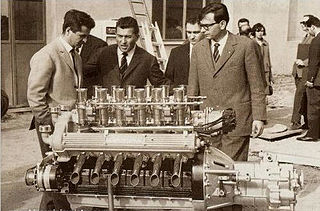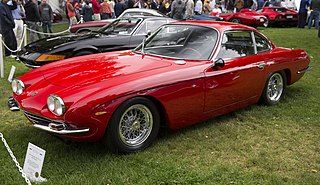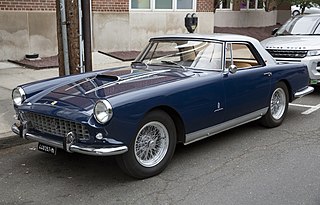
Dino was a marque best known for mid-engined, rear-drive sports cars produced by Ferrari from 1957 to 1976. The marque came into existence in late 1956 with a front-engined Formula Two racer powered by a brand new Dino V6 engine. The name Dino was used for some models with engines smaller than 12 cylinders, it was an attempt by the company to offer a relatively low-cost sports car. The Ferrari name remained reserved for its premium V12 and flat-12 models until 1976, when "Dino" was retired in favour of full Ferrari branding.

Zagato is a coachbuilding company. The design centre of the company is located in Terrazzano, a small village near Rho, Lombardy, Italy. The company's premises occupies an area of 23,000 square metres.

ASA was an Italian automobile manufacturer active from 1961 to 1969, who is known for manufacturing the ASA 1000 GT. This car was developed by Ferrari engineers in the late 1950s as a less expensive, compact alternative to existing Ferrari GT cars. ASA used inline-four and straight-six engines derived from the "250" 3-litre V12 designed by Gioacchino Colombo. The chassis was developed by Giotto Bizzarrini and was derived from the tubular frame chassis of the 250 GTO.

The Ferrari 250 GTO is a GT car produced by Ferrari from 1962 to 1964 for homologation into the FIA's Group 3 Grand Touring Car category. It was powered by Ferrari's Tipo 168/62 Colombo V12 engine.

Carrozzeria Scaglietti was an Italian automobile design and coachbuilding company active in the 1950s. It was founded by Sergio Scaglietti in 1951 as an automobile repair concern, but was located across the road from Ferrari in Maranello outside Modena, Italy.

Carrozzeria Touring Superleggera is an Italian automobile coachbuilder. Originally established in Milan in 1925, Carrozzeria Touring became well known for both the beauty of its designs and patented superleggera construction methods. The business folded in 1966. In 2006 its brands and trademarks were purchased and a new firm established nearby to provide automotive design, engineering, coachbuilding, homologation services, non-automotive industrial design, and restoration of historic vehicles.

The Ferrari 250 is a series of sports cars and grand tourers built by Ferrari from 1952 to 1964. The company's most successful early line, the 250 series includes many variants designed for road use or sports car racing. 250 series cars are characterized by their use of a 3.0 L (2,953 cc) Colombo V12 engine designed by Gioacchino Colombo. They were replaced by the 275 and 330 series cars.

Bizzarrini S.p.A. is an Italian automotive manufacturer: in 1964 it was founded by former Alfa Romeo, Ferrari and Iso engineer Giotto Bizzarrini. The company built a small number of highly developed and advanced sport and racing automobiles before failing in 1969: in 2020, it was announced that the name had been acquired by Pegasus brands, together with plans to restart production.
The Ferrari P was a series of Italian sports prototype racing cars produced by Ferrari during the 1960s and early 1970s.

Giotto Bizzarrini is an Italian automobile engineer who was active from the 1950s through the 1970s.

The Bizzarrini Strada, is a sports car produced by Bizzarrini from 1964 to 1968. Sold as an exceptionally low slung 2-seat coupe, roadster, and track-tuned "Corsa" racer, it proved to be Bizzarrini's most successful model.

The Ferrari 250 GT SWB Breadvan is a one-off Ferrari made in 1962 from a 1961 Ferrari 250 GT Berlinetta SWB, chassis number 2819 GT. It was built to compete against the new 1962 Ferrari 250 GTO at the 24 Hours of Le Mans and other FIA World Sportscar Championship races.

The Lamborghini 350 GT is a grand tourer manufactured by Lamborghini between 1964 and 1966. It was the first production vehicle produced by Lamborghini. The 350 GT was based on the earlier Lamborghini 350 GTV and was equipped with a 3.5 liter V12 engine and a 2-door coupé body by Carrozzeria Touring. The 350 GT debuted at the March 1964 Geneva Motor Show and production began the following May. The success of this model ensured the company's survival, establishing it as a viable competitor with rival manufacturer Ferrari.

Lamborghini 400 GT is the name given to two grand tourers produced by Italian manufacturer Lamborghini.

The Iso Grifo is a limited production grand tourer manufactured by Italian automobile manufacturer Iso Autoveicoli S.p.A. between 1965 and 1974. Intended to compete with Grand Touring offerings from Ferrari and Maserati, it used a series of American power trains and components supplied by Chevrolet and Ford. Styling was done by Giorgetto Giugiaro at Bertone, while the mechanicals were the work of Giotto Bizzarrini.

The Ferrari Monza is one of a series of cars built by Ferrari. In the early 1950s, Ferrari shifted from using the compact Gioacchino Colombo-designed V12 engine in its smallest class of sports racers to a line of four-cylinder engines designed by Aurelio Lampredi. Inspired by the success of the light and reliable 2.5 L 553 F1 car, the four-cylinder sports racers competed successfully through the late 1950s, culminating with the famed 500 Mondial and 750 Monza.

The Velo Rossa is a fibre reinforced plastic composite automobile body built by Reaction Research in Scottsdale, Arizona, USA. It is designed to re-style the body of the 1970-1978 Datsun/Nissan S30 Z series cars. Front end appearance panels are replaced. Doors and rear external components are over-skinned after trimming out the wheel wells for wider tires.

The Ferrari 250 GT Coupé represented a series of road-going, grand touring cars produced by Ferrari between 1954 and 1960. Presented at the 1954 Paris Motor Show, the 250 Europa GT was the first in the GT-lineage. The design by Pinin Farina was seen as a more civilised version of their sporty Berlinetta 250 MM. Series built cars were an answer to the wealthy clientele demands of a sporty and luxurious Ferrari Gran Turismo, that is also easier to use daily.
Thomas Meade was an American automobile designer and dealer best known for his Thomassima series of custom cars based on Ferrari engines and chassis. He was based in Modena, Italy from the early 1960s through the early 1970s, where he met and collaborated with many Modenese carrozzerie, manufacturers and mechanics.

The AMC AMX/3 is a mid-engine sports car made by the United States Automobile manufacturer American Motors Corporation (AMC), which was presented in March 1970 and was to be mass-produced in Germany by Karmann from 1971. With this car, AMC wanted to counter the similarly designed De Tomaso Pantera with a competitor. The body design and drivetrain came from AMC, the chassis and suspension were developed in Europe. The design was generally attributed to Giotto Bizzarrini. However, only individual components such as the suspension come from him. In addition to Bizzarrini, Italdesign, Autocostruzioni S.D. and BMW were also involved in the development. Shortly after the presentation, AMC abandoned the project without giving any reason after about half a dozen cars had been made. Several attempts to revive the design without AMC's involvement under the Bizzarrini brand name as the Bizzarrini Sciabola were unsuccessful. An AMX/3 chassis formed the technical basis for the Iso Varedo concept car in 1972.
























